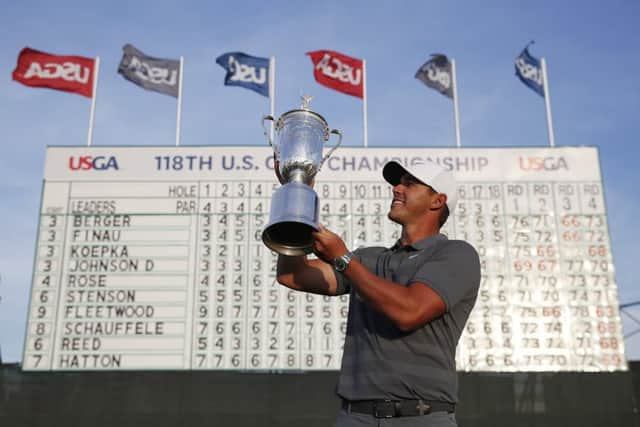Brooks Koepka eyeing third US Open win in bid to match North Berwick’s Willie Anderson


This week sees the staging of the 119th US Open at Pebble Beach in California where one of the favourites will be Brooks Koepka, aiming for his third consecutive title in the major. Should he succeed, he will join Scot Willie Anderson in an elite club of two, as the only players in the history of the game to achieve that feat.
In all, North Berwick-born Anderson won four US Open titles, between 1901 and 1905, a statistic that places him in exalted company alongside golfing royalty Bobby Jones, Ben Hogan and Jack Nicklaus, the only others to have claimed that total although none managed three in a row.
Advertisement
Hide AdAdvertisement
Hide AdIn addition to his wins Anderson also notched seven top-five placings in the event, a remarkable record. Although he may not share the celebrity of those illustrious figures, he was reckoned on his day to be as good a player as Jones and Hogan, according to fellow North Berwick native Fred Macleod who won the US Open in 1908 and played with all of them during a lengthy career. Back then Scots almost “owned” the championship, recording nine successes between 1901 and 1910, with Laurie Auchterlonie, Alex Smith and Alec Ross also winning, making it particularly regrettable that no Scot will be teeing up next week.


Like many at the time in North Berwick, Anderson was steeped in the game as a youngster, his father a greenkeeper in the town while he was a licensed caddie on the West Links aged 11 before becoming an apprentice clubmaker with Alex Aitken of Gullane.
When he emigrated to the States in 1896 aged 16 for an appointment as professional at a club on Rhode Island, his playing career began to flourish.
He first came to prominence the following year, finishing runner-up in the US Open and a year later was third. In 1901 he enjoyed his maiden success at Myopia Hunt Club, near Boston, beating fellow Scot Alex Smith after a play-off. At that time professionals were treated as second-class citizens, denied access to clubhouse facilities. When officials instructed Anderson and his colleagues to eat in the kitchen, the Scots protested forcefully, obliging the organisers to erect a marquee for their dining.
The first of his consecutive wins came in 1903 at Baltusrol where he had previously been professional. After a record opening 73, he tied for the title with “Deacon” Brown, from Musselburgh, whom he defeated in a play-off. The following year he won at Glen View in Illinois with a record final round of 72, covering the last eight holes in two under par to win by five strokes, incredible scoring with his eight basic clubs.
In 1905 he clinched his third consecutive championship, again at Myopia.
In addition to those successes he also won the Western Open four times, the other top tournament of the era.
Over 14 years he was attached to ten different clubs, his contract in 1906 with the Onwentsia club in Illinois reputedly making him the country’s highest paid professional. Another lucrative source of income were 36-hole challenge matches and it was following one in 1910 that he died suddenly at home in Philadelphia aged 31. There was speculation over the cause of death, some attributing it to over-indulgence with alcohol which has since been discredited, with the true reason discovered to be epilepsy.
Advertisement
Hide AdAdvertisement
Hide AdHe was buried in Ivy Hill cemetery in Philadelphia with a headstone provided by the Eastern Professional Golfers Association.
Although popular among his colleagues with whom he enjoyed socialising, the golfing public were rather indifferent to him which caused some agonising as he confided in fellow pro and Scot Tom Mercer “they don’t know me…”
That in part was probably down to his demeanour on the course where he was considered dour, but his approach was that of the professional, totally focused on winning. He did not court popularity and was often taciturn. Nor did he conform to the standards of the time, choosing to play in basic garb of baggy trousers, plain shirt, old tweed jacket and a cloth neckerchief.
Described as having the build of a middleweight boxer with powerful forearms and broad shouldered, his mantra was: “To think of nothing but golf while engaged in playing golf is the secret to success.”
Opponents reckoned his strongest asset was his temperament. In some traits he shares a passing resemblance to the powerful Koepka, whose manner has been described as “chill”, with a strong temperament and committed approach to the game. Like Anderson, he also went abroad to develop his career, memorably winning the Scottish Hydro Challenge in Aviemore in 2013 during three years in Europe. According to him, he was “so focused on golf, nothing else mattered”. Perhaps the stars will align for him in California.